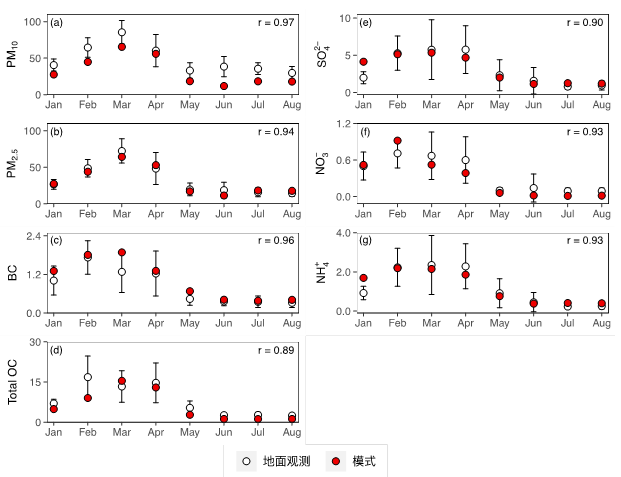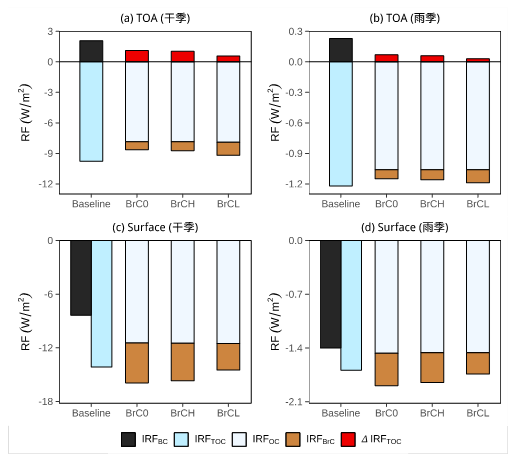Brown carbon aerosols and their radiative forcing have been the focus of climate change research in recent years, and biomass combustion is an important source of brown carbon aerosols. During the dry season in Chiang Mai, Thailand (usually from February to April), there are frequent mountain fires, intensive agricultural burning activities, vigorous biomass burning, and a large amount of brown carbon aerosols are discharged into the atmosphere. Brown carbon has a significant absorption effect on solar radiation in the ultraviolet-visible light band, which can heat the atmosphere and affect local climate. However, the current research on the impact of biomass burning in Chiang Mai, Thailand on the local climate is very limited, and there is a lack of assessment of brown carbon radiative forcing.
The research group of Associate Professor PENG Yiran, Department of Earth System Science, Tsinghua University, aimed at the scientific problem of biomass combustion and its climate impact in Chiang Mai, Thailand. Based on the atmospheric chemistry model GEOS-Chem, a series of simulation experiments were carried out to quantitatively evaluate the radiative forcing of carbon aerosols from biomass combustion and the contribution of brown carbon. Recently, the research results were published in the high-impact journal of Earth System Science "Atmospheric Environment" with the title "Contribution of brown carbon to the light absorption and radiative effect of carbonaceous aerosols from biomass burning emissions in Chiang Mai, Thailand".
In this study, the separation method was used in the simulation experiment to realize the simulation of brown carbon, that is, the introduction of brown carbon as a separate tracking component, which is different from organic carbon that has no absorption effect on solar radiation. Since the optical properties of brown carbon still have large uncertainties, this study designed three sets of sensitivity tests of strong absorption of brown carbon (BrCH), moderate absorption (BrCO) and weak absorption (BrCL) to explore the influence of the optical properties of brown carbon on its radiative forcing. By comparing with various aerosol concentration observed on the ground, the simulation experiment can better reappear the aerosol concentration level and seasonal changes in Chiang Mai area (Figure 1). The simulated radiative forcing results are shown in Figure 2. The local top-of-atmosphere (TOA) instantaneous radiative forcing caused by brown carbon aerosols during the dry season in Chiang Mai is -0.97±0.27 W/m2, which is 14±3% of the total radiative forcing of carbon aerosols. In addition, considering the absorptivity of brown carbon, the sum of TOA instantaneous radiative forcing (IRFTOC) of brown carbon and organic carbon is weakened by 9±3%, while the ground IRFTOC is enhanced by 9±5%, indicating that brown carbon can retain more solar radiation in the atmosphere, and can have a significant impact on the local climate in Chiang Mai. This study quantitatively assessed the direct impact of brown carbon, the biomass burning source, on the climate of Chiang Mai, Thailand, and provided a reference for the assessment of brown carbon radiative forcing in Southeast Asia and the biomass burning source area.
Doctoral student ZHANG Ying from Department of Earth System Science of Tsinghua University is the first author of the paper, Associate Professor PENG Yiran of Department of Earth System Science is the corresponding author of the paper, Professor ZHANG Yanlin and SONG Wenhuai from Nanjing University of Information Science and Technology, Professor Tippawan Prapamontol and student Pitakchon Ponsawansong from Chiang Mai University in Thailand, and Associate Professor WANG Yuxuan of Houston University are the co-author of the thesis. This research was supported by the National Natural Science Foundation of China (No. 41761144056, No. 71690243 and No. 41775137) and Thailand Science Research and Innovation; No. RDG 6030019.

Figure 1
Observed and simulated concentrations of (a) PM10, (b) PM2.5, (c) black carbon (BC), (d) total organic carbon (TOC, including brown carbon and organic carbon), (e) sulfate (SO42-), (f) nitrate (NO3-), (g) ammonium (NH4+) near the ground. The figure also marked the correlation coefficient (r) between the simulated aerosol concentration and the observed concentration.

Figure 2
The transient radiative forcing (IRF) caused by black carbon (BC), organic carbon (OC) and brown carbon (BrC) at the top of the atmosphere (TOA) and the surface based on model evaluation, and the top of the atmosphere caused by brown carbon changes in IRFTOC (∆IRFTOC). Baseline is the benchmark simulation test, which treats brown carbon as organic carbon that does not absorb solar radiation.
Full text link: https://doi.org/10.1016/j.atmosenv.2021.118544
Text: ZHANG Ying
Editor: WANG Jiayin
Review: WU Haiping